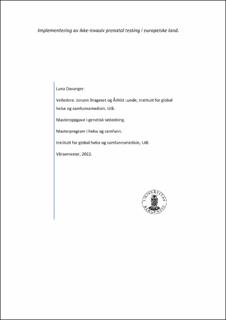| dc.contributor.author | Davanger, Luna Blaauw | |
| dc.date.accessioned | 2022-08-30T23:47:24Z | |
| dc.date.available | 2022-08-30T23:47:24Z | |
| dc.date.issued | 2022-06-22 | |
| dc.date.submitted | 2022-08-30T22:00:11Z | |
| dc.identifier.uri | https://hdl.handle.net/11250/3014573 | |
| dc.description.abstract | Hensikten med studien er å danne en oversikt over hvordan andre europeiske land med tilsvarende helsevesen har implementert ikke-invasiv prenatal testing. Studien ønsker å besvare hvordan landene har planlagt, undersøkt og gjennomført implementasjon av ikke-invasiv prenatal testing som screeningmetode, samt hvilken informasjon og veiledning som er gitt de gravide, og hvilken påvirkning dette hadde på antall invasive undersøkelser. Metoden tar utgangspunkt i kvantitativ forskning, og studiedesignet er en litteraturstudie med systematisk tilnærming. Litteraturen ble samlet inn fra PubMed, EMBASE, Medline og CINAHL, og sortert via Rayyan. Alle inkluderte artikler ble kritisk vurdert. Gjennom litteratursøket, ble 11 artikler inkludert i litteraturstudien. Disse omhandler seks land som har implementert ikke-invasiv prenatal testing i varierende grad. Nederland og Storbritannia gjennomførte landsomfattende implementeringsstudier, mens andre land innførte tilbudet ved enkeltsentre eller sykehus. I alle landene ble gravide veiledet av en jordmor gjennom førstetrimester undersøkelsen, hvor det ble gitt informasjon rundt fordeler, ulemper og risiko. Tilbudet blir i de fleste tilfeller finansiert av staten, og tilbys gratis til gravide. I alle landene vises det til stor nedgang i invasive tester etter implementasjon av det ikke-invasive tilbudet, på mellom 50 % og 62 %. | |
| dc.description.abstract | The purpose of this study is to form an overview of how other European countries with similar health care have implemented non-invasive prenatal testing. The study wants to answer how other countries have planned, investigated, and implemented non-invasive prenatal testing as a screening method, as well as what information and counselling has been given to pregnant women, and what impact this had on the number of invasive tests. Quantitative research methods, and literature review with a systematic approach as study design. Literature was collected from PubMed, EMBASE, Medline and CINAHL, and sorted using Rayyan. All included articles were critically reviewed. 11 articles were included through the literature search. These cover six countries that have implemented non-invasive prenatal testing. The Netherlands and the United Kingdom conducted nationwide implementation studies, while other countries introduced it at individual centres or hospitals. Pregnant women were supervised by a midwife through the first trimester survey, which provided information on the benefits, disadvantages, and risks. It is in most cases financed by the state offered free of charge. All the countries show a large decrease in invasive tests after implementation of non-invasive prenatal testing, of between 50 % and 62 %. | |
| dc.language.iso | nob | |
| dc.publisher | The University of Bergen | |
| dc.rights | Copyright the Author. All rights reserved | |
| dc.subject | Primær screeningmetode | |
| dc.subject | Genetisk veiledning. | |
| dc.subject | Implementeringsstudier | |
| dc.subject | Ikke-invasiv prenatal testing | |
| dc.subject | Aneuploidiscreening | |
| dc.subject | Nasjonalt screeningprogram | |
| dc.title | Implementering av ikke-invasiv prenatal testing i europeiske land. | |
| dc.title.alternative | Implementation of noninvasiv prenatal testing in European countries. | |
| dc.type | Master thesis | |
| dc.date.updated | 2022-08-30T22:00:11Z | |
| dc.rights.holder | Copyright the Author. All rights reserved | |
| dc.description.degree | Genetisk rettleiing: masteroppgave | |
| dc.description.localcode | GENV399 | |
| dc.description.localcode | MAMD-HESAM | |
| dc.subject.nus | 769915 | |
| fs.subjectcode | GENV399 | |
| fs.unitcode | 13-26-0 | |
